Interview with Tim Gallagher, Author of The Grail Bird
I finally have managed to get the email interview with Tim Gallagher, author of the newly released book, The Grail Bird, ready for you to read. I sent the questions to him later than I had said I would (this past Sunday, to be exact) because my end-of-semester obligations took up more time than I ever imagined possible. But Tim was a very good sport and answered very quickly, as you can see. So without further ado, here is the interview for your reading pleasure.
====
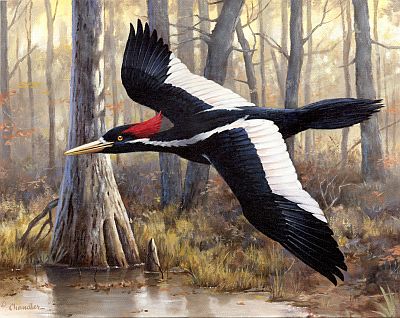
"Elusive Ivory" by Larry Chandler.
This question is from a reader, Mike; I've noticed that many individuals online are concerned that the ivory-bill is commanding a disproportionate level of attention and resources while other less charismatic species are still being ignored. Though I'm not worried about this at all, I wonder if Mr. Gallagher has any insight into what other at-risk species will benefit from IBW conservation efforts.
Every living thing in that southern bottomland swamp forest habitat -- birds, mammals, fishes, reptiles, plants, you name it -- will benefit from the conservation work being done on behalf of the ivory-bill. And that's no small accomplishment. Throughout our history, this has been one of the most neglected habitats in America. At a time when people were saving Yellowstone, Yosemite, and so many other great places, no one did anything for the southern swamp forests. And they were well worth saving. When the Civil War ended, they were still an immense wilderness of towering trees, full of bears, wolves, panthers, and other magnificent animals -- including the ivory-billed woodpecker. But it didn't take long for the large logging interests to move in and start cutting. Millions of board feet a year were harvested for decade after decade after decade, until little of consequence was left. We had a chance to save the Singer Tract -- an 80,000 acre remnant of primeval forest in northeastern Louisiana -- in the early 1940s, but we didn't do it. We let it slip away. We should be very thankful that we have a charismatic bird like the ivory-bill to help us preserve and enhance and expand the bottomland swamp forest habitat of the South.
An anonymous reader asks; I guess while other skeptics are expressing themselves, I'd like to ask Mr. Gallagher if all the scientists and conservation experts involved in this rediscovery really think the government should be spending so much money on the possibility of there being more than one woodpecker when so many other species need help. (Habitat preservation aside.)
Well, this question implies that if money were not spent on the ivory-bill, it would be spent on these other worthy but neglected species. Sadly, this is probably not the case. The funds would most likely be spent on something completely unrelated to conservation. At least if we help the ivory-bill, we're helping every other plant and animal species present in these bottomland forests. I should also point out that so far the lion's share of the funding for research and land acquisition has come from private donors, not the government, and this will probably continue.
Do you have confidence that the Nature Conservancy has the funds and other resources available to protect adequate habitat for these birds? If so, what makes you so confident?
They've certainly got a great track record with this project so far, with more than 18,000 acres of forest saved since our sighting. And they'd already done some excellent work in the Big Woods of Arkansas in earlier years, helping to save the very bayou where we saw the bird. Twenty years ago it had been slated to be channelized. Imagine that. There would have been no trees at all, just a straight channel going for miles.
Do you think that the current administration has the political will to protect these birds' habitat? If so, why do you think this?
Well, that's the big question, isn't it? And I don't know the answer. But it was very gratifying to see the Secretary of the Interior and the Secretary of Agriculture pledge $10 million to help save the bird and its habitat. I hope they see it through and do what is necessary to protect and expand the ivory-bill's habitat.
Another anonymous reader asks; I'm sorry to say it, but I'm put off mightily by the fact that announcement of the rediscovery of the Ivory-bill was delayed until a snappy logo was created, not just one but several websites were designed, a magazine article was prepared, (auto?) biographies were written, and, oh, yes, Tim Gallagher's book (and Terri Roberts Luneau's children's book) were readied for publication. Is someone also selling Ivory-bill coffee? And Ivory-bill t-shirts? Scott Weidensaul quotes John Fitzpatrick as asking, "You know what? Our lives are going to change." Just what, I wonder, did he mean by that?
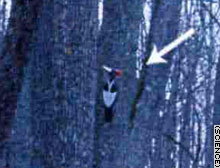 The delay in announcing the rediscovery of the ivory-bill had nothing to do with designing logos, web sites, etc. We didn't even think about any of that until fairly recently. Our primary concern has always been the well-being of the species. We needed time to develop plans for research, conservation, and public education. The first research goal was to get physical proof of the bird's existence. When Bobby Harrison, Gene Sparling, and I came out of the swamp in February 2004, we had only our word that we had seen an ivory-bill. Although that's enough for people who know me, we knew that the world at large would demand solid proof. For more than half a century, scientists have regarded ivory-bill sightings as being the same as Bigfoot or Elvis sightings. We had hoped -- and believed -- that we would be able to find a nest or at least a roost hole and take excellent photographs and videos of ivory-bills, but unfortunately this didn't happen. Every sighting was brief, with no chance to raise a camera and take a picture. David Luneau only got his video of the bird because he kept his camcorder running constantly and it happened to be pointed in the right direction as the bird took off. The only other video we got in 14 months was one taken by Bobby Harrison, and the glimpse of the bird it provided was even shorter than David's. Over these months we did develop and hone our search technique, but it's been a daunting task. So far, we've only searched about eight percent of the forest in the area.
The delay in announcing the rediscovery of the ivory-bill had nothing to do with designing logos, web sites, etc. We didn't even think about any of that until fairly recently. Our primary concern has always been the well-being of the species. We needed time to develop plans for research, conservation, and public education. The first research goal was to get physical proof of the bird's existence. When Bobby Harrison, Gene Sparling, and I came out of the swamp in February 2004, we had only our word that we had seen an ivory-bill. Although that's enough for people who know me, we knew that the world at large would demand solid proof. For more than half a century, scientists have regarded ivory-bill sightings as being the same as Bigfoot or Elvis sightings. We had hoped -- and believed -- that we would be able to find a nest or at least a roost hole and take excellent photographs and videos of ivory-bills, but unfortunately this didn't happen. Every sighting was brief, with no chance to raise a camera and take a picture. David Luneau only got his video of the bird because he kept his camcorder running constantly and it happened to be pointed in the right direction as the bird took off. The only other video we got in 14 months was one taken by Bobby Harrison, and the glimpse of the bird it provided was even shorter than David's. Over these months we did develop and hone our search technique, but it's been a daunting task. So far, we've only searched about eight percent of the forest in the area.I'm happy to say that our conservation efforts are moving ahead quickly. Since February 2004, the Nature Conservancy has placed more than 18,000 additional acres into conservation in the Big Woods area of Arkansas. The web sites, press releases, and other media materials were part of the public education effort, as were the descriptive panels put in place at the designated visitation areas. We knew that everyone would want to learn more about the ivory-bill as soon as the story came out, and that's why we created all the educational materials and web sites.
As for my book, it was well underway before we saw the bird in Arkansas. In some ways, the book led directly to the rediscovery, because I was following up on seemingly credible reports across the South -- the ones that everyone was writing off as Elvis sightings -- when Bobby Harrison and I checked out Gene Sparling's sighting and saw the bird. Otherwise, I'm afraid Gene's excellent sighting would have gone unnoticed like so many others.
About John Fitzpatrick's statement that our lives were going to change, I think he was warning me that we were crossing the Rubicon, and there was no turning back. We were completely embracing the idea that the ivory-billed woodpecker still exists -- and putting our careers on the line. From that day on, we knew that this bird would be the focal point of our lives for years -- perhaps forever -- and it was a sobering thought.
A friend, Ian, also asks what was meant when Fitz said "You know what? Our lives are going to change." Ian says that you all still have to go to work every day, still have to do the same mundane tasks, so how exactly does this event/sighting change your lives?
Yes, we still have to go to work each day and do the same tasks. The only difference is that now we have two full-time jobs -- in my case, editing Living Bird magazine and working on the ivory-bill project. But the deepest change is in the focus of my life. I seem to spend most of my waking hours now thinking about the ivory-bill and what we can do to help it. This has completely changed my direction and my goals.
What do you think of using aviculture to help increase the numbers of this bird, as they are using successfully for the California Condor? [I am especially thinking of removing some eggs and using artificial incubation until they hatch (to increase egg/chick production) combined with fostering the chicks under other woodpecker species until they can be replaced into an ivory-billed woodpecker nest while still nestlings and possibly providing additional feedings to the nestlings several times per day]
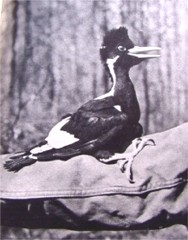 I'm nervous about using such a hands-on approach at this point. I worked on the peregrine falcon recovery in the 1970s, and that was a wonderful success using aggressive techniques such as manipulation of wild nests, captive breeding, and massive reintroduction efforts in areas where the falcons had vanished. But this was a special case. Raptors (even wild-trapped adults) adapt readily to captivity. This had been proven by countless falconers over the centuries. Condors proved to be similarly successful at adapting to captivity and producing young in artificial conditions. I'm not sure things would work out as well for ivory-bills. These are shy, secretive birds. Trying to trap them and keep them in aviaries could prove disastrous -- and just suggesting such a plan would be very controversial. I believe in this case we'll have to help these birds the old-fashioned way by protecting and expanding their habitat. I don't think there's any shortcut here.
I'm nervous about using such a hands-on approach at this point. I worked on the peregrine falcon recovery in the 1970s, and that was a wonderful success using aggressive techniques such as manipulation of wild nests, captive breeding, and massive reintroduction efforts in areas where the falcons had vanished. But this was a special case. Raptors (even wild-trapped adults) adapt readily to captivity. This had been proven by countless falconers over the centuries. Condors proved to be similarly successful at adapting to captivity and producing young in artificial conditions. I'm not sure things would work out as well for ivory-bills. These are shy, secretive birds. Trying to trap them and keep them in aviaries could prove disastrous -- and just suggesting such a plan would be very controversial. I believe in this case we'll have to help these birds the old-fashioned way by protecting and expanding their habitat. I don't think there's any shortcut here.Is anyone considering installing a nestbox cam into an active ivory-billed woodpecker nest? These cams are getting ever smaller and are not very intrusive, and I think it could be a great fund-raising or public-relations campaign. If free access to the webcam is provided to the public, it could reduce the numbers of people wandering the swamps in search of these birds, too.
It might be risky and would certainly be controversial to install a nestbox cam inside an ivory-bill's nest cavity. But we have talked about having one of these cameras on an adjacent tree, aimed right at the cavity, so that the public could watch the comings and goings of the ivory-bills. But first we've got to find a nest or roost hole.
A reader, Tabor asks; I'd like to know if he thinks there is a good breeding population or was this just a lucky sighting of one bird in a tiny population? Also, is there an effort underway (perhaps you birders already know this), to expand habitat for this species?
I think this is clearly a very small population, or the birds would be much easier to find. Some people have asked me if I think this is the last ivory-bill in the world. I truly doubt it; the odds against it are astronomical. These birds probably only live 10 to 15 years, so this bird was hatched in the 1990s or perhaps even in this century, more than 50 years after scientists had written off the species. That in itself is a miracle. A major effort is now underway to expand the habitat for these birds. Since our sighting of the bird in February 2004, the Nature Conservancy has already placed more than 18,000 additional acres into conservation in the Big Woods area of Arkansas, and that's just the beginning.
I (and an anonymous reader) was quite bothered about Jerome Jackson's lack of any sort of role in the search for the ivory-billed woodpecker. We both ask; I'm curious to know how it was determined who would be on the large, secret search team; I'm especially wondering why Dr. Jerome Jackson, who has done extensive work on the IBWO, written a book about them, wrote the Birds of North America account on them, and participated in the Zeiss search, was not included or even told about the discovery.
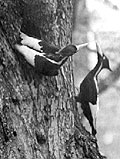 I did not have a prominent role in determining who would be included in the search team. A key concern from the start was to keep the story of the bird's sighting quiet until we'd had time to search the sighting area thoroughly and determine whether the bird was breeding. This process would have been greatly complicated if crowds of birders or the media had descended on the swamp at that time. Obviously, this would be the hottest birding story imaginable. We knew as soon as it hit the Internet, the story would be circling the globe in minutes. Let's face it, all birders are blabbermouths, myself included. The only way to keep it quiet was to tell as few people as possible. Everyone had to be approved by the core group of researchers and had to sign nondisclosure agreements. I have many good friends and colleagues who are angry with me because I didn't tell them about the ivory-bill, but I think it was good to keep it quiet. One of the most remarkable things about all this is that we kept things quiet for fourteen months. As for Jerry Jackson, I have nothing but respect for him. He is one of the few scientists who kept hope alive for the ivory-bill when so many others had written it off.
I did not have a prominent role in determining who would be included in the search team. A key concern from the start was to keep the story of the bird's sighting quiet until we'd had time to search the sighting area thoroughly and determine whether the bird was breeding. This process would have been greatly complicated if crowds of birders or the media had descended on the swamp at that time. Obviously, this would be the hottest birding story imaginable. We knew as soon as it hit the Internet, the story would be circling the globe in minutes. Let's face it, all birders are blabbermouths, myself included. The only way to keep it quiet was to tell as few people as possible. Everyone had to be approved by the core group of researchers and had to sign nondisclosure agreements. I have many good friends and colleagues who are angry with me because I didn't tell them about the ivory-bill, but I think it was good to keep it quiet. One of the most remarkable things about all this is that we kept things quiet for fourteen months. As for Jerry Jackson, I have nothing but respect for him. He is one of the few scientists who kept hope alive for the ivory-bill when so many others had written it off.I have one last question; Do you think that Mary Scott really saw the ivory-billed woodpecker? It seems impossible for one person to see such an astonishingly rare bird not once, not twice, but three times (!) in such a short time period.
I admit I'm not sure about Mary Scott's first two sightings. She was new to ivory-bill searching at that time, and it's impossible to say for certain what she saw. But after that, she became totally committed to learning everything she could find out about this species. She created a lecture and slide show and took it on the road. By the time she went to the White River in March 2003, she really knew what she was looking for. So it's much harder to dismiss that third sighting. She stepped out
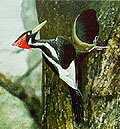 of a car, she saw a large woodpecker fly up and land on a tree trunk, and she locked her binoculars on it. The way she described this bird to me was perfect for an ivory-bill -- and nothing else. Did she dream it? Did she make it up? I don't think so. To me she seems perfectly credible. I've played the recording of my interview with her for several people -- including a couple of skeptics -- and all agree that she is completely sincere; she believes she saw an ivory-bill. I might add that the habitat where she saw the bird is some of the best I've seen. I should also say that the first thing I did after interviewing Gene Sparling for the first time was to look at a map and determine how far his sighting area was from Mary's. They were about 48 miles apart, connected almost the entire way by a narrow corridor of forest. Would I have checked out Gene's sighting if it hadn't been so close to where Mary had seen her bird? Probably not.
of a car, she saw a large woodpecker fly up and land on a tree trunk, and she locked her binoculars on it. The way she described this bird to me was perfect for an ivory-bill -- and nothing else. Did she dream it? Did she make it up? I don't think so. To me she seems perfectly credible. I've played the recording of my interview with her for several people -- including a couple of skeptics -- and all agree that she is completely sincere; she believes she saw an ivory-bill. I might add that the habitat where she saw the bird is some of the best I've seen. I should also say that the first thing I did after interviewing Gene Sparling for the first time was to look at a map and determine how far his sighting area was from Mary's. They were about 48 miles apart, connected almost the entire way by a narrow corridor of forest. Would I have checked out Gene's sighting if it hadn't been so close to where Mary had seen her bird? Probably not.=====
I would like to thank Taryn Roeder from Houghton Mifflin publishers for suggesting this interview and for setting it up, Tim Gallagher for taking time from his very busy schedule to write thoughtful answers to these questions, and most of all, I'd like to thank you, dear readers, for asking interesting and lively questions. I had so much fun with this. If you have follow-up questions that you'd like to ask, Tim is willing to answer them. He says that it may take a couple weeks because he has other commitments (a job, for example) that he needs to take care of.
=====
Several images linked from;
Rediscovering the ivory-billed woodpecker, Cornell Laboratory of Ornithology.
Search for the ivory-billed woodpecker, National Public Radio's Radio Expeditions.
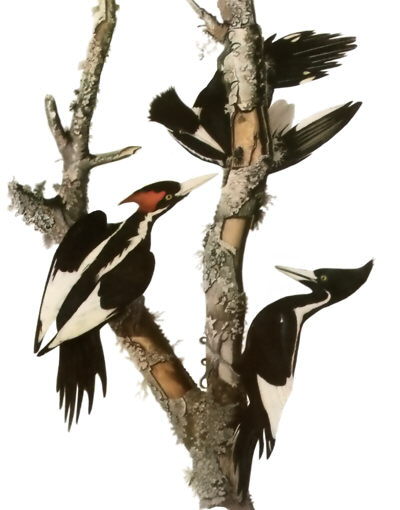
Ivory-billed Woodpeckers.
By John James Audubon, from his book, The Birds of America
© 2004, 2005, 2006 by GrrlScientist











6 Peer Reviews:
Ok, I'll be honest, birds never did much for me. I think on some level I do appreciate them, and have this odd sort of fascination about them (the dinosaur connection is interesting, surely), but I never "got into" them --- but then we all have our own niche, like birds themselves, I suppose.
Anyway, good job, and thanks for sharing. I did get a chance to see a bit into the minds of true bird lovers, and I wasn't scared or scarred, and that's good.
Wow! Some of those questions seemed hostile. Tim was awfully nice about it.
I'm glad he is certain that there's a population and not just a lone bird. It gives me hope.
You know, my bird book (Peterson, I think) has a picture of an IBWP in it with a notation that it is believed extinct. I always wondered why they needed it there for comparison if they believed it was gone for good. I think the birding community never truly lost hope.
Thanks for your many postings on this, GrrlSci.
A note from a new bird-lover-- Thanks for working so hard on this story. This interview is quite good for getting some of the thinking going on behind the scenes of such an event.
Thanks for following up the most thoughtful, comprehensive IBWO coverage on the web after the story broke with this well done interview. Your questions were direct and valid and Tim responded in kind.
Hmmm, how about that commerative T-shirt? It will remain a special day in my life!
Hi! Mr Gallagher is certainly diplomatic about the Bush Administration. They are doing all they can to eviscerate the Endangered Species Act & the other laws & rulings put in place to preserve the environment. Big Oil rules! Shame on them!
Hi C. corax .. yes some questions did seem hostile, but I chose not to edit them (to tone them down). But practice makes perfect; I'd bet that Tim has ansswered other, equally hostile, questions and will continue to do so in the future, too.
I am not sure why the Peterson Guide would illustrate an Ivory-billed Woodpecker, but they may have shown it because it was never officially declared extinct by the USFWS, although other organizations did declare them extinct.
Thanks everyone for reading and commenting!
GrrlScientist
Post a Comment
<< Home